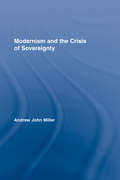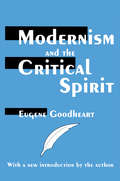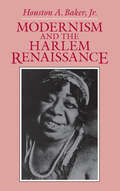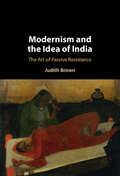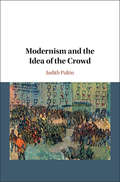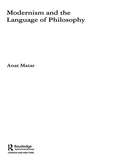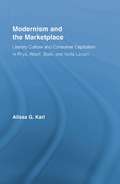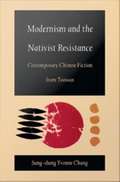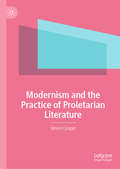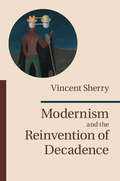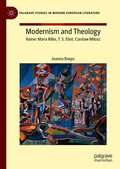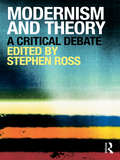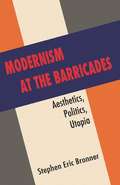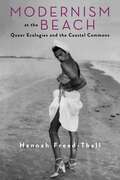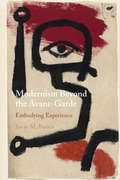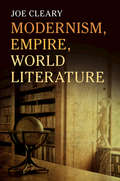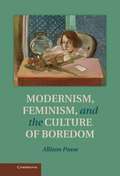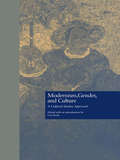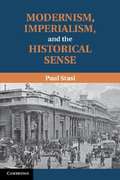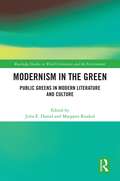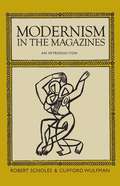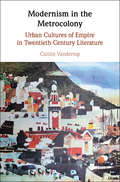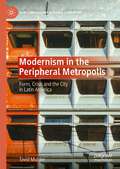- Table View
- List View
Modernism and the Crisis of Sovereignty (Routledge Studies in Twentieth-Century Literature #4)
by Andrew John MillerThis book describes how three of the most significant Anglophone writers of the first half of the twentieth century – Yeats, Eliot, and Woolf – wrestled with a geopolitical situation in which national boundaries had come to seem increasingly permeable at the same time as war among (and within) individual nation-states had come to seem virtually inescapable. Drawing on Jean-François Lyotard's analysis of the elements of performativity in J.L. Austin's speech act theory, and making critical use of Carl Schmitt’s writings on sovereignty and world order, Miller situates the writings of Yeats, Eliot, and Woolf in the context of what Lyotard describes as a "civil war of language." By virtue of its dissolution of any clear boundary between "interiority" and "exteriority," as well as by virtue of its resistance to any decisive form of resolution or regulation, this "civil war of language" takes on dimensions that are ultimately global in scope. Miller examines the emergence of modernism as bound up with a crisis of personal, political, and aesthetic sovereignty that undermined traditional distinctions between the public and private. In the process, he directly engages with the theoretical discourse surrounding the geopolitical impact of globalization and biopolitics: a discourse that is central to the influential and widely-debated work of such varied figures as Carl Schmitt, Hardt and Negri, Giorgio Agamben, and Jean-Luc Nancy. This book will be of interest to anyone concerned not only with twentieth-century literature but also with questions of nationalism and globalization.
Modernism and the Critical Spirit
by Eugene GoodheartComplaints about the decline of critical standards in literature and culture in general have been voiced for much of the twentieth century. These have extended from F.R. Leavis's laments for a "lost center of intelligence and urbane spirit," to current opposition to the predominance of radical critical theory in contemporary literature departments. Humanist criticism, which has as its object the quality of life as well as works of art, may well lack authority in the contemporary world. Even amid the disruptions of the industrial revolution, nineteenth-century humanists such as Matthew Arnold, John Ruskin, and Thomas Carlyle could assume a positive order of value and shared habits of imaginative perception and understanding between writers and readers. Eugene Goodheart argues that, by contrast, contemporary criticism is infused with the skepticism of modernist aesthetics. It has willfully rejected the very idea of moral authority.Goodheart starts from the premise that questions about the moral authority of literature and criticism often turn upon a prior question of what happens when the sacred disappears or is subjected to the profane. He focuses on contending spiritual views, in particular the dialectic between the Protestant-inspired, largely English humanist tradition of Carlyle, Ruskin, Arnold, and D.H. Lawrence and the decay of Catholicism represented by James Joyce and T.S. Eliot. Goodheart argues that literary modernism, in distancing itself from natural and social vitality, tends to render suspect all privileged positions. It thereby undermines the critical act, which assumes the priority of a particular set of values. Goodheart makes his case by analyzing the work of a variety of novelists, poets, and critics, nineteenth century and contemporary. He blends literary theory and practical criticism.
Modernism and the Harlem Renaissance
by Houston A. Baker Jr."Mr. Baker perceives the harlem Renaissance as a crucial moment in a movement, predating the 1920's, when Afro-Americans embraced the task of self-determination and in so doing gave forth a distinctive form of expression that still echoes in a broad spectrum of 20th-century Afro-American arts. . . . Modernism and the Harlem Renaissance may well become Afro-America's 'studying manual.'"—Tonya Bolden, New York Times Book Review
Modernism and the Idea of India: The Art of Passive Resistance
by Judith BrownIn his 1909 manifesto Hind Swaraj, Gandhi made an impassioned call for passive resistance that he soon retracted. 'Passive resistance' didn't, in the end, serve his overarching aims, but was troubled on multiple grounds from its use of the English phrase to the weakness implied by passivity. Modernism and the Idea of India: The Art of Passive Resistance claims that the difficulty embedded in the phrase 'passive resistance', from its seeming internal contradiction to the troubling category of passivity itself, transforms in artistic expression, where its dynamism, ambivalence, and receptivity enable art's capacity to create new forms of meaning. India provides the ground and the fantasy for writers and artists including Rabindranath Tagore, R.K. Narayan, Ahmed Ali, Amrita Sher-Gil, Virginia Woolf, and Le Corbusier. These artists and writers explore the capacities of passive resistance inspired by Gandhi's treatise, but move beyond its call for activism into new languages of art.
Modernism and the Idea of the Crowd
by Judith PaltinThis book argues that modernists such as James Joyce and Virginia Woolf engaged creatively with modernity's expanding forms of collective experience and performative identities. Judith Paltin compares patterns of crowds in modernist Anglophone literature to historical arrangements and theories of democratic assembly to argue that an abstract construction of the crowd engages with the transformation of popular subjectivity from a nineteenth-century liberal citizenry to the contemporary sense of a range of political multitudes struggling with intersectional conditions of oppression and precarity. Modernist works, many of which were composed during the ascendancy of fascism and other populist politics claiming to be based on the action of the crowd, frequently stage the crowd as a primal scene for violence; at the same time, they posit a counterforce in more agile collective gatherings which clarify the changing relations in literary modernity between subjects and power.
Modernism and the Language of Philosophy (Routledge Studies in Twentieth-Century Philosophy)
by Anat MatarModernism can be characterised by the acute attention it gives to language, to its potential and its limitations. Philosophers, artists and literary critics working in the first third of the twentieth century emphasized language’s creative potential, but also stressed its inability to express meaning completely and accurately. In particular, modernists shared the belief that the kind of truth sub specie aeterni that was sought by philosophers was either meaningless or was more appropriately expressed by the arts – especially by literature and poetry. Modernism and the Language of Philosophy addresses the challenge this belief presented to philosophy, and argues that the modernist assumption rests upon a host of unacknowledged, repressed or denied dogmas or tacit images. Drawing in particular upon the work of Michale Dummett and Jacques Derrida, this book explores a new solution to this crisis in philosophical language, and it is these two philosophers who drive the narrative of the book and offer perspectives through which both past and present day philosophers are examined.
Modernism and the Marketplace: Literary Culture and Consumer Capitalism in Rhys, Woolf, Stein, and Nella Larsen (Literary Criticism and Cultural Theory)
by Alissa G. KarlThough the relationship of modernist writers and artists to mass-marketplaces and popular cultural forms is often understood as one of ambivalence if not antagonism, Modernism and the Marketplace redirects this established line of inquiry, considering the practical and conceptual interfaces between literary practice and dominant economic institutions and ideas.
Modernism and the Materiality of Texts
by Eyal AmiranModernism and the Materiality of Texts argues that elements of modernist texts that are meaningless in themselves are motivated by their authors' psychic crises. Physical features of texts that interest modernist writers, such as sound patterns and anagrams, cannot be dissociated from abstraction or made a refuge from social crisis; instead, they reflect colonial and racial anxieties of the period. Rudyard Kipling's fear that he is indistinguishable from empire subjects, J. M. Barrie's object-relations theater of infantile separation, and Virginia Woolf's dismembered anagram self are performed by the physical text and produce a new understanding of textuality. In readings that also include diverse works by Gertrude Stein and Alice Toklas, P. G. Wodehouse and Conan Doyle, J. M. Barrie, George Herriman, and Sigmund Freud, this study produces a new reading of modernism's psychological text and of literary constructions of materiality in the period.
Modernism and the Nativist Resistance: Contemporary Chinese Fiction from Taiwan
by Sung-sheng Yvonne ChangThe first comprehensive English-language study of literary trends in the fiction of Taiwan over the last forty years, this pioneering work explores a rich tradition of literary Modernism in its shifting relationship with Chinese politics and culture. Situating her subject in its historical context, Sung-sheng Yvonne Chang traces the connection between Taiwan's Modernists and the liberal scholars of pre-Communist China. She discusses the Modernists' ambivalent relationship with contemporary Taiwan's conservative culture, and provides a detailed critical survey of the strife between the Modernists and the socialistically inclined, anti-Western Nativists. Chang's approach is comprehensive, combining Chinese and comparative perspectives. Employing the critical insights of Raymond Williams, Peter Burger, M. M. Bahktin, and Fredric Jameson, she investigates the complex issues involved in Chinese writers' appropriation of avant-gardism, aestheticism, and various other Western literary concepts and techniques. Within this framework, Chang offers original, challenging interpretations of major works by the best-known Chinese Modernists from Taiwan. As an intensive introduction to a literature of considerable quality and impact, and as a case study of the global spread of Western literary Modernism, this book will be of great interest to students of Chinese and comparative literature, and to those who wish to understand the broad patterns of twentieth-century literary history.
Modernism and the Practice of Proletarian Literature
by Simon CooperThis book tests critical reassessments of US radical writing of the 1930s against recent developments in theories of modernism and the avant-garde. Multidisciplinary in approach, it considers poetry, fiction, classical music, commercial art, jazz, and popular contests (such as dance marathons and bingo). Relating close readings to social and economic contexts over the period 1856–1952, it centers in on a key author or text in each chapter, providing an unfolding, chronological narrative, while at the same time offering nuanced updates on existing debates. Part One focuses on the roots of the 1930s proletarian movement in poetry and music of the nineteenth and early twentieth centuries. Part Two analyzes the output of proletarian novelists, considered alongside contemporaneous works by established modernist authors as well as more mainstream, popular titles.
Modernism and the Reinvention of Decadence
by Vincent SherryIn this major new book, Vincent Sherry reveals a fresh continuity in literary history. He traces the idea of decadence back to key events from the failures of the French Revolution to the cataclysm of the Great War. This powerful work of literary criticism and literary history encompasses a rich trajectory that begins with an exposition of the English Romantic poets and ends with a reevaluation of modernists as varied as W. B. Yeats, Henry James, Joseph Conrad. Rebecca West, Djuna Barnes, Samuel Beckett, and, centrally, Ezra Pound and T. S. Eliot. Sherry's hugely ambitious study will be essential reading for anyone working in modernist studies and twentieth-century literature more generally.
Modernism and Theology: Rainer Maria Rilke, T. S. Eliot, Czesław Miłosz (Palgrave Studies in Modern European Literature)
by Joanna RzepaThis is the first book-length study to examine the interface between literary and theological modernisms. It provides a comprehensive account of literary responses to the modernist crisis in Christian theology from a transnational and interdenominational perspective. It offers a cultural history of the period, considering a wide range of literary and historical sources, including novels, drama, poetry, literary criticism, encyclicals, theological and philosophical treatises, periodical publications, and wartime propaganda. By contextualising literary modernism within the cultural, religious, and political landscape, the book reveals fundamental yet largely forgotten connections between literary and theological modernisms. It shows that early-twentieth-century authors, poets, and critics, including Rainer Maria Rilke, T. S. Eliot, and Czesław Miłosz, actively engaged with the debates between modernist and neo-scholastic theologians raging across Europe. These debates contributed to developing new ways of thinking about the relationship between religion and literature, and informed contemporary critical writings on aesthetics and poetics.
Modernism and Theory: A Critical Debate (Routledge Studies In Human Geography Ser.)
by Stephen RossModernism and Theory boldly asks what – if any – role theory has to play in the new modernist studies. Separated into three sections, each with a clear introduction, this collection of new essays from leading critics outlines ongoing debates on the nature of modernist culture. This collection examines aesthetic and methodological links between modernist literature and theory. addresses questions of the importance of theory to our understanding of ‘modernism’ and modernism as a literary category. considers intersections of modernism and theory within ethics, ecocriticism and the avant-garde. Concluding with an afterword from Fredric Jameson, the book makes use of an innovative dialogic format, offering a direct and engaging experience of the current debate in modernist studies. Contributors include: Charles F. Altieri, C.D. Blanton, Ian Buchanan, Pamela Caughie, Melba Cuddy-Keane, Thomas S. Davis, Oleg Gelikman, Jane Goldman, Ben Highmore, Fredric Jameson, Martin Jay, Bonnie Kime Scott, Neil Levi, Anneleen Masschelein, Scott McCracken, Andrew John Miller, Stephen Ross, Roger Rothman, Morag Shiach, Susan Stanford Friedman, Allan Stoekl, Hilary Thompson and Glenn Willmott.
Modernism at the Barricades: Aesthetics, Politics, Utopia (Columbia Studies In Political Thought/Political History (coup))
by Stephen Eric BronnerStephen Eric Bronner revisits the modernist project's groundbreaking innovations, itsexperimental imagination, and its utopian politics. Reading the artistic and intellectual achievements of the movement's leading figures against larger social, political, and cultural trends, he follows the rise of a flawed yet salient effort at liberation and its confrontation with modernity.Modernism at the Barricades features chapters on expressionism, futurism, surrealism, and revolutionary art and includes fresh perspectives on the work of Arnold Schoenberg, Wassily Kandinsky, and Emil Nolde, among others. The volume illuminates an international avant garde intent on resisting bureaucracy, standardization, scientific rationality, and the increasing commodification of mass culture. Modernists sought new ways of feeling, new forms of expression, and new possibilities of experience while seeking to refashion society. Liberation was their aim, along with the invigoration of daily life—yet their process entangled political resistance with the cultural. Exploring both the political responsibility of the artist and the manipulation of authorial intention, Bronner reconfigures the modernist movement for contemporary progressive purposes and offers insight into the problems still complicating cultural politics. He ultimately reasserts the political dimension of developments often understood in purely aesthetic terms and confronts the self-indulgence and political irresponsibility of certain so-called modernists today. The result is a long overdue reinterpretation and rehabilitation of the modernist legacy for a new age.
Modernism at the Beach: Queer Ecologies and the Coastal Commons (Modernist Latitudes)
by Hannah Freed-ThallAt the beach, bodies converge with the elements and strange treasures come to light. Departing from the conventional association of modernism with the city, this book makes a case for the coastal zone as a surprisingly generative setting for twentieth-century literature and art. An unruly and elusive confluence of human and more-than-human forces, the seashore is also a space of performance—a stage for loosely scripted, improvisatory forms of embodiment and togetherness.The beach, Hannah Freed-Thall argues, was to the modernist imagination what mountains were to Romanticism: a space not merely of anthropogenic conquest but of vital elemental and creaturely connection. With an eye to the peripheries of capitalist leisure, Freed-Thall recasts familiar seaside practices—including tide-pooling, beachcombing, gambling, and sunbathing—as radical experiments in perception and sociability. Close readings of works by Marcel Proust, Virginia Woolf, Claude McKay, Samuel Beckett, Rachel Carson, and Gordon Matta-Clark, among others, explore the modernist beach as a queer refuge, a precarious commons, a scene of collective exhaustion and endurance, and a visionary threshold at the end of the world.Interweaving environmental humanities, queer and feminist theory, and cultural history, Modernism at the Beach offers new ways of understanding twentieth-century literature and its relation to ecological thought.
Modernism Beyond the Avant-Garde: Embodying Experience
by Jason M. BaskinCritics have traditionally maintained that capitalism's resurgence after the Second World War precipitated the transition from modernism to postmodernism. This revisionist account shows that modernism does not simply decline. By foregrounding phenomenological conceptions of bodily experience, Jason M. Baskin reveals modernism's ongoing vitality. Key postwar writers, critics and philosophers, including Elizabeth Bishop, Ezra Pound, Ralph Ellison and Raymond Williams, as well as Maurice Merleau-Ponty and Theodor Adorno, developed an aesthetics of embodiment that adapted modernism to a new postwar landscape. Working across differences of race, gender, national and intellectual tradition, genre and form, Baskin contends that these authors used ordinary bodily experiences, such as perception, memory and laughter, to imagine modes of common being and purpose that were otherwise unavailable in a postwar society dominated by liberal capitalism.
Modernism, Empire, World Literature
by Joe ClearyAfter World War I, American, Irish and then Caribbean writers boldly remade the world literary system long dominated by Paris and London. Responding to literary renaissances and social upheavals in their own countries and to the decline of war-devastated Europe, émigré and domestic-based writers produced dazzling new works that challenged London's or Paris's authority to fix and determine literary value. In so doing, they propounded new conceptions of aesthetic accomplishment that were later codified as 'modernism'. However, after World War II, an assertive American literary establishment repurposed literary modernism to boost the cultural prestige of the United States in the Cold War and to contest Soviet conceptions of 'world literature'. Here, in accomplished readings of major works and essays by Henry James, Ezra Pound, W. B. Yeats, T. S. Eliot, James Joyce, F. Scott Fitzgerald, Eugene O'Neill and Derek Walcott, Joe Cleary situates Anglophone modernism in terms of the rise and fall of European and American empires, changing world literary systems, and disputed histories of 'world literature'.
Modernism, Feminism, and the Culture of Boredom
by Allison PeaseBored women populate many of the most celebrated works of British modernist literature. Whether in popular offerings such as Robert Hitchens's The Garden of Allah, the esteemed middlebrow novels of May Sinclair or H. G. Wells, or now-canonized works such as Virginia Woolf's The Voyage Out, women's boredom frequently serves as narrative impetus, antagonist and climax. In this book, Allison Pease explains how the changing meaning of boredom reshapes our understanding of modernist narrative techniques, feminism's struggle to define women as individuals and male modernists' preoccupation with female sexuality. To this end, Pease characterizes boredom as an important category of critique against the constraints of women's lives, arguing that such critique surfaces in modernist fiction in an undeniably gendered way. Engaging with a wide variety of well- and lesser-known modernist writers, Pease's study will appeal especially to researchers and graduates in modernist studies and British literature.
Modernism, Gender, and Culture: A Cultural Studies Approach (Wellesley Studies in Critical Theory, Literary History and Culture #Vol. 11)
by Lisa Rado"First Published in 1997, Routledge is an imprint of Taylor & Francis, an informa company."
Modernism, Imperialism and the Historical Sense
by Paul StasiModernist art and literature sought to engage with the ideas of different cultures without eradicating the differences between them. In Modernism, Imperialism and the Historical Sense, Paul Stasi explores the relationship between high modernist aesthetic forms and structures of empire in the twentieth century. Stasi's text offers new readings of James Joyce, Ezra Pound, T. S. Eliot and Virginia Woolf by situating their work within an early moment of globalization. By combining the insights of Marxist historiography, aesthetic theory and postcolonial criticism, Stasi's careful analysis reveals how these authors' aesthetic forms responded to, and helped shape, their unique historical moment. Written with a wide readership in mind, this book will appeal especially to scholars of British and American literature as well as students of literary criticism and postcolonial studies.
Modernism in Kyiv
by Virlana Tkacz Irena MakarykThe study of modernism has been largely focused on Western cultural centres such as Paris, Vienna, London, and New York. Extravagantly illustrated with over 300 photos and reproductions, Modernism in Kyiv demonstrates that the Ukrainian capital was a major centre of performing and visual arts as well as literary and cultural activity. While arguing that Kyiv's modernist impulse is most prominently displayed in the experimental work of Les Kurbas, one of the masters of the early Soviet stage, the contributors also examine the history of the city and the artistic production of diverse groups including Ukrainians, Russians, Jews, and Poles.Until now a silent presence in Western accounts of the cultural topography of modernism, multicultural Kyiv is here restored to its historical, intellectual, and artistic complexity. Excerpts taken from the works of artists, writers, and critics as well as the numerous illustrations help give life to the exciting creativity of this period. The first book-length examination of this subject, Modernism in Kyiv is a breakthrough accomplishment that will become a standard volume in the field.
Modernism in the Green: Public Greens in Modern Literature and Culture (Routledge Studies in World Literatures and the Environment)
by Julia E. Daniel Margaret KonkolModernism in the Green traces a trans-Atlantic modernist fascination with the creation, use, and representation of the modern green. From the verdant public commons in the heart of cities to the lookout points on mountains in national parks, planned green spaces serve as felicitous stages for the performance of modernism. In its focus on designed and public green zones,Modernism in the Green offers a new perspective on modernism’s overlapping investments in the arts, politics, urbanism, race, class, gender, and the nature-culture divide. This collection of essays is the first to explore the prominent and diverse ways greens materialize in modern literature and culture, along with the manner in which modernists represented them. This volume presents the idea of "the green" as a point of exploration, as our contributors analyze social-organic spaces ranging from public parks to roadways and refuse piles. Like the term "green," one that evokes both more-than-human natural zones and crafted public meeting places, these chapters uncover the social and spatial intersection of nature and culture in the very architecture of parks, gardens, buildings, highways, and dumps. This book argues that such greens facilitate modernists’ exploration of how nature can manifest in an era of increasing urbanization and mechanization and what identities and communities the green now enables or prevents.
Modernism in the Magazines: An Introduction
by Robert Scholes Clifford WulfmanIf modernism began in the magazines, as Robert Scholes and Clifford Wulfman argue, then the study of modern culture should begin with these publications. Scholes and Wulfman's radically inclusive approach not only considers the "little" modernist magazines alongside the "big" or mass magazines often dismissed as antithetical to modernism's elite culture, but also insists that scholars must investigate their contents as a whole--from poetry to advertising--to appreciate their full significance. The book's appendix also reprints a previously uncollected critique of popular British magazines from 1917 and 1918 by Ezra Pound.
Modernism in the Metrocolony: Urban Cultures of Empire in Twentieth-Century Literature
by Caitlin VandertopWhile literary modernism is often associated with Euro-American metropolises such as London, Paris or New York, this book considers the place of the colonial city in modernist fiction. From the streets of Dublin to the shop-houses of Singapore, and from the botanical gardens of Bombay to the suburbs of Suva, the monumental landscapes of British colonial cities aimed to reinforce empire's universalising claims, yet these spaces also contradicted and resisted the impositions of an idealised English culture. Inspired by the uneven landscapes of the urban British empire, a group of twentieth-century writers transformed the visual incongruities and anachronisms on display in the city streets into sources of critique and formal innovation. Showing how these writers responded to empire's metrocolonial complexities and built legacies, Modernism in the Metrocolony traces an alternative, peripheral history of the modernist city.
Modernism in the Peripheral Metropolis: Form, Crisis and the City in Latin America (New Comparisons in World Literature)
by Tavid MulderThis book shows how Latin American writers and artists in the crisis-decades of the 1920s and 1930s used modernist techniques to explore national issues in relation to global capitalism. Drawing on a rich interdisciplinary archive of novels, poetry, essays, photography, and architecture, it includes chapters on major figures and the transformations that marked Latin American cities at the beginning of the twentieth century: the poet Manuel Maples Arce and Mexico City; the essayist José Carlos Mariátegui and Lima; the novelist Roberto Arlt and Buenos Aires; the novelist Patrícia Galvão and São Paulo. Tavid Mulder argues that the Latin American city should be understood as a peripheral metropolis: a social space that is simultaneously peripheral relative to the center of the world economy and a metropolis in relation to the region’s vast, underdeveloped hinterlands. Conceiving of modernist techniques as ways of understanding how the dualisms of Latin American societies—urban and rural, wealth and poverty, cosmopolitan and national—are bound together by the internal contradictions of capitalism, this volume insists on the ability of literary and artistic works to grasp the process through which untenable situations of crisis are not overcome but stabilized in the periphery. It thereby sheds light on issues in Latin America that have become increasingly urgent in the twenty-first century: inequality, indigenous migration, surplus populations, and anomie.
